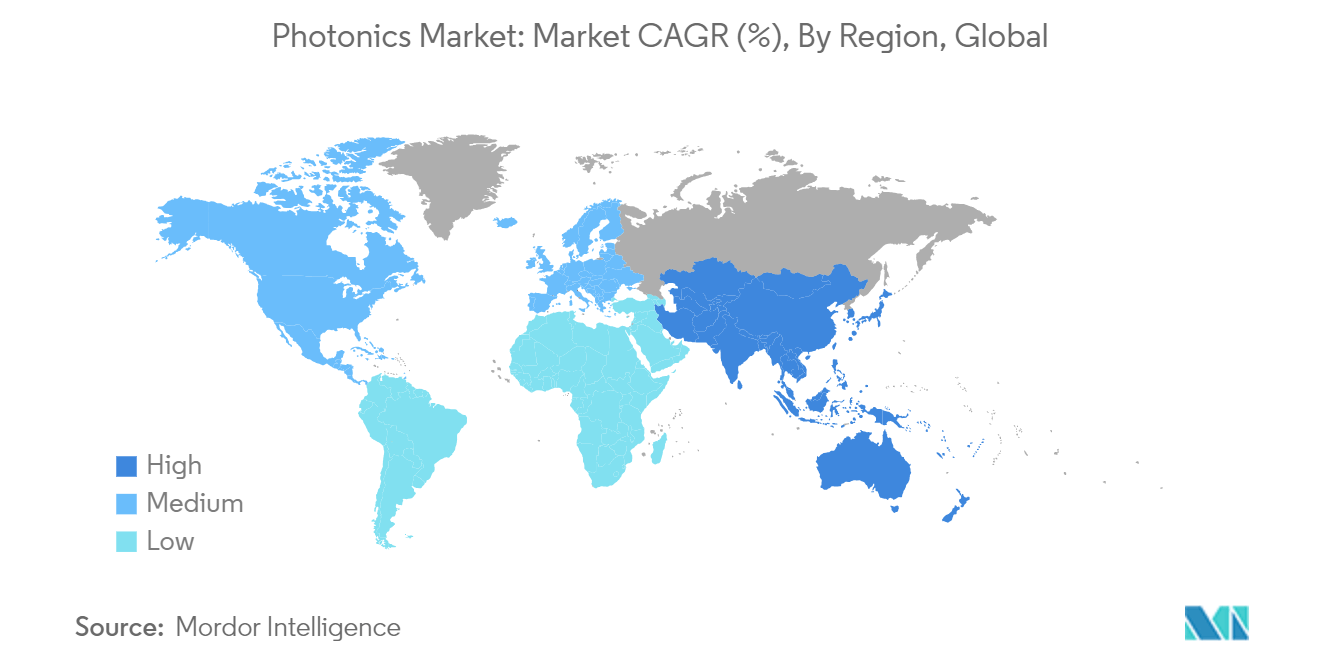Market Trends of Photonics Industry
Consumer End-user Industry Segment Holds Significant Market Share
- Photonics are utilized in several consumer devices like barcode scanners, DVD players, TV remote controls, televisions, smartphones, etc. Barcode scanners are commonly used in consumer equipment like printers, CD/DVD/Blu-ray devices, and remote devices. Barcode scanners play a crucial role in logistics and supply chain management. They are used for scanning barcodes on product packages and shipping labels to track inventory, manage stock levels, and ensure accurate delivery.
- Photonics-based barcode scanners are used for package sorting in logistics applications. These scanners help automate sorting packages based on their barcode information. They are also extensively used in retail environments, including point-of-sale transactions, inventory management, and price verification. They enable quick and accurate scanning of product barcodes, improving efficiency and customer service.
- Photonics technology also plays a crucial role in the functioning of DVD players. DVD players utilize photonics technology in their optical disc drives, including CD, DVD, Blu-ray, and HD (high-definition) players and recorders. DVD players use lasers for reading and writing data on optical discs. The laser diode emits a focused, narrow beam of light that can be directed onto the surface of the disc, allowing for precise data retrieval and recording. DVD players are optical disc players that rely on photonics technology to read and write data on DVDs. The laser beam emitted by the laser diode interacts with the pits and lands on the DVD’s surface, allowing the player to retrieve the stored information.
- According to the Consumer Technology Association (CTA) and the US Census Bureau, the sales value of smartphones sold in the United States was expected to increase from USD 73 billion in 2021 to USD 74.7 billion in 2022. Additionally, according to GSMA, in North America, the number of smartphone subscribers is expected to reach 328 million by 2025. Moreover, by 2025, North America may witness an increase in the penetration rates of mobile subscribers (86%) and the Internet (80%). The increasing demand and industry trends for mobile phones are likely to offer lucrative opportunities for the growth of the market studied.
- Moreover, the US Census Bureau estimated the smartphone sales value to be USD 74.7 billion during 2022-2023. This sluggish growth is an outcome of declined smartphone shipments in the United States. Low-end smartphone sales declines were the most significant contributing factor to the downturn amid economic challenges, high inflation, and poor seasonal demand. However, this is expected to end in the coming years. These industry trends are expected to impact smartphone camera lens growth significantly.

Asia-Pacific to Register Major Growth in the Global Market
- Japan is a high-tech powerhouse economy in Asia. The global camera industry is rapidly evolving, and Japan is a consistent leader and innovator in the market. Mirror-less hybrid cameras, DSLRs, and compact interchangeable-lens cameras now drive the camera market, further creating opportunities for the market studied.
- The country has many universities and institutes related to photonics. For instance, the Photonics Advanced Research Center (PARC) at Osaka University in Japan has emerged as a leading scientific and industrial research center for Japan's photonics.
- China is expected to exhibit a significant growth rate among countries in Asia-Pacific, owing to the region’s growing economy and the global electronics market share. China is one of the prominent electronics producers and consumers. The manufacturing industry is rapidly growing in the region and witnessing the deployment of various manufacturing and telecommunications technologies, which is expected to aid the market's growth.
- India is one of the largest and fastest-growing economies in the world. The growing purchasing power and the rising influence of social media are expected to drive the market for electronic goods. The government is undertaking many initiatives to become one of the developed economies. The Ministry of Electronics and Information Technology, India, approves various digital projects, creating significant market growth opportunities over the forecast period.
- South Korea is one of the significant contributors to the market. The growing population, increasing investments toward developing silicon photonic products, international and domestic players' rising focus on developing modern silicon photonic products, and the improving R&D activities to increase the region's data transmission rate fuel the market growth.
- The countries considered part of the rest of the Asia-Pacific include Indonesia, Singapore, and Thailand. The rapid development of 5G, AI, the internet of things (IoT), virtual reality (VR), and the commercial application of such new technologies increase the demand for data processing and information interaction. This scenario may boost the construction of data centers in the region, leading to explosive industry growth.


